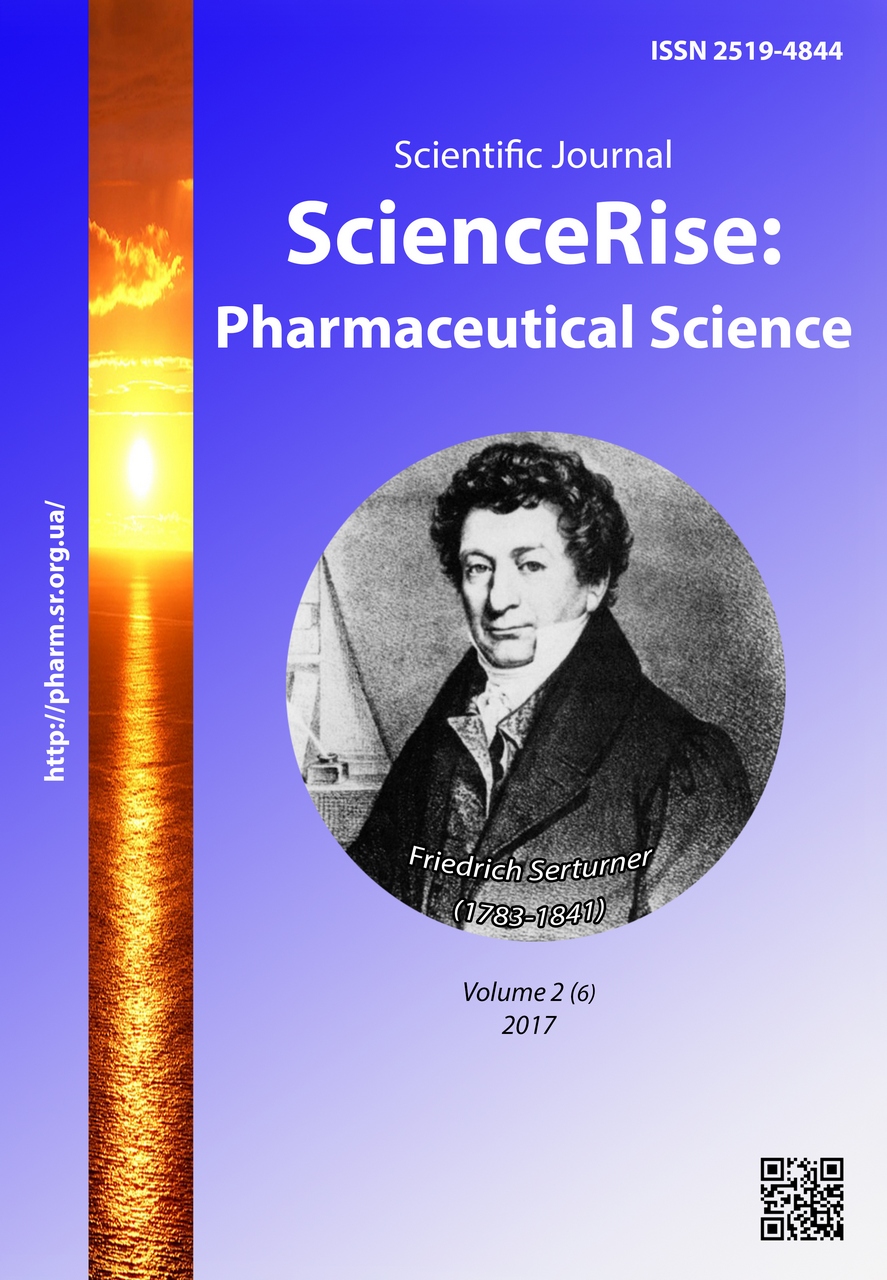Хромато-мас-спектрометричне дослідження низькомолекулярних аліфатичних, жирних та ароматичних кислот кореневища Veronica teucrium L.
DOI:
https://doi.org/10.15587/2519-4852.2017.99317Ключові слова:
Veronica teucrium L., аліфатичні кислоти, жирні кислоти, ароматичні кислоти, хромато-мас-спектрометріяАнотація
Мета. Хромато-мас-спектрометричне визначення якісного складу та кількісного вмісту аліфатичних, ароматичних та жирних кислот у кореневищах Veronica teucrium L.
Методи. Об’єктом дослідження були кореневища V. teucrium L., заготовлені в Харківській області у 2015 році. Аналіз метилових естерів кислот проводили з використанням хромато-мас-спектрометру 5973N/6890N MSD/DS Agilent Technologies. Введення проби до хроматографічної капілярної колонки INNOWAX (0,25 мм×30 м) проводили у режимі splitless. Ідентифікацію метилових естерів кислот проводили на основі розрахунку еквівалентної довжини аліфатичного ланцюга (ECL) з використанням даних бібліотеки мас-спектрів NIST 05 і Willey 2007 у поєднанні з програмами для ідентифікації AMDIS і NIST; також порівнювали час утримання естерів з часом утримання стандартних сполук (Sigma). Для кількісних розрахунків використовували метод внутрішнього стандарту.
Результати дослідження. Вперше проведено дослідження карбонових кислот кореневищ Veronica teucrium L. з використанням хромато-мас-спектрометричного методу, в результаті якого виявлено та встановлено вміст 10 аліфатичних, 16 жирних та 9 ароматичних кислот. Загальний вміст ідентифікованих карбонових кислот у кореневищах вероніки широколистої складає 3068,06 мг/% (3,07 %). Серед низькомолекулярних аліфатичних кислот домінують яблучна, лимонна та левулінова; серед жирних кислот – насичені: міристинова, пальмітинова та лігноцеринова і ненасичені: олеїнова, лінолева та ліноленова. Особливе значення мають визначені ароматичні кислоти: бензойна, фенолкарбонові: ванілінова, вератрова, р-гідроксибензойна, гентизинова, бузкова та гідроксикорична: р-кумарова.
Висновки. Вперше в кореневищі V. teucrium L. виявлено та встановлено вміст 10 низькомолекулярних аліфатичних, 16 жирних та 9 ароматичних кислот з використанням методу хромато-мас-спектрометрії
Посилання
- Albach, D. C., Grayer, R. J., Jensen, S. R., Ozgokce, F., Veitch, N. C. (2003). Acylated flavone glycosides from Veronica. Phytochemistry, 64 (7), 1295–1301. doi: 10.1016/j.phytochem.2003.08.012
- Belenovskaya, L., Korhov, V., Mac, M., Medvedeva, L. (Eds.) (1990). Rastitelnyye resursy SSSR. Tsvetkovyye rasteniya, ikh khimicheskiy sostav, ispolzovaniye. Semeystvo Caprifoliaceae – Plantaginaceae. Leningrad: Nauka, 328.
- Mocan, A., Vodnar, D., Vlase, L., Crisan, O., Gheldiu, A.-M., Crisan, G. (2015). Phytochemical characterization of Veronica officinalis L., V. teucrium L. and V. orchidea Crantz from Romania and their antioxidant and antimicrobial properties. International Journal of Molecular Sciences, 16 (9), 21109–21127. doi: 10.3390/ijms160921109
- Chekhirova, G. V., Aseyeva, Т. А., Каshin, V. K. (2012). Rasteniya semeystva Scrophulariaceae v tibetskoy meditsine. Vestnik buryatskogo gosudarstvennogo universiteta, S/2012, 181–184.
- Gusev, N. F., Nemereshina, О. N. (2012). Poisk vitaminosnykh rasteniy v stepnoy i lesostepnoy zonakh orenburgskogo preduralya. Nauka Krasnodarya, 1, 19–27.
- Jensen, S. R., Albach, D. C., Ohno, T., Grayer, R. J. (2005). Veronica: Iridoids and cornoside as chemosystematic markers. Biochemical Systematics and Ecology, 33 (10), 1031–1047. doi: 10.1016/j.bse.2005.03.001
- Zivkovic, J., Cebovic, T., Maksimovic, Z. (2012). In vivo and in vitro antioxidant effects of three Veronica spesies. Open Life Sciences, 7 (3), 559–568. doi: 10.2478/s11535-012-0041-4
- Beara, I., Zivkovic, J., Lesjak, M., Ristic, J., Savikin, K., Maksimovic, Z., Jankovic, T. (2015). Phenolic profile and anti-inflammatory activity of three Veronica species. Industrial Crops and Products, 63, 276–280. doi: 10.1016/j.indcrop.2014.09.034
- Bubenchikova, V. N., Kondratova, Yu. A. (2010). Rasteniya roda Veronika. Kursk: GOU VPO KGMUroszdrava, 104.
- Crisan, G., Vlase, L., Balica, G., Muntean, D., Stefanescu, C., Paltinean, R. et. al. (2010). LC/MC analysis of aukubin and catalpol of some Veronica species. Farmacia, 58 (2), 237–242.
- Osmachko, A. P., Kovaleva, A. M. (2016). Pharmacognostic study of Veronica teucrium L. herb. 2nd International Young Scientists Symposium «Plants in Pharmacy & Nutrition». Wroclaw: Wroclaw Medical University, 132.
- Osmachko, А. P., Kovaleva, А. М., Iliina, Т. V., Koshovii, О. N. (2015). Doslidzhennya fenolnikh rechovin travi Veronica teucrium L. Zbirnik naukovikh prats spivrobitnikiv NMAPO іm. P. L. Shupika, 24 (5), 118–123.
- Nour, V., Trandafir, I., Cosmulescu, S. (2012). HPLC Determination of Phenolic Acids, Flavonoids and Juglone in Walnut Leaves. Journal of Chromatographic Science, 51 (9), 883–890. doi: 10.1093/chromsci/bms180
- Ghasemzadeh, A., Ghasemzadeh, N. (2011). Flavonoids and phenolic acids: Role and biochemicalactivity in plants and human. Journal of Medicinal Plants Research, 5 (31), 6697–6703. doi: 10.5897/jmpr11.1404
##submission.downloads##
Опубліковано
Як цитувати
Номер
Розділ
Ліцензія
Авторське право (c) 2017 Alina Osmachko, Alla Kovaleva, Ilyina Tatyana, Oleg Koshovyi, Natali Sidora

Ця робота ліцензується відповідно до Creative Commons Attribution 4.0 International License.
Наше видання використовує положення про авторські права Creative Commons CC BY для журналів відкритого доступу.









